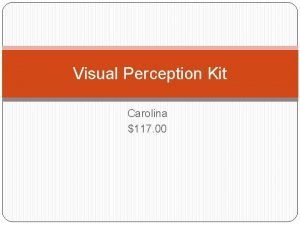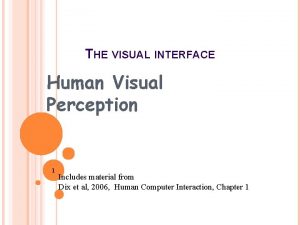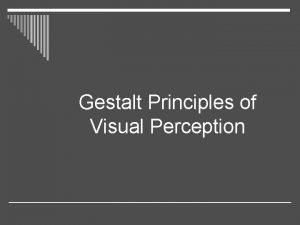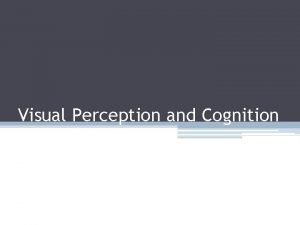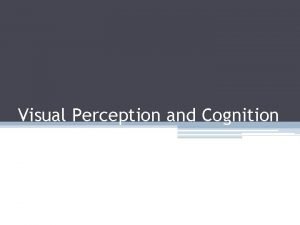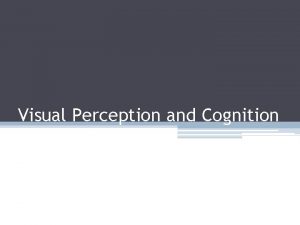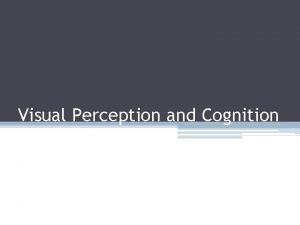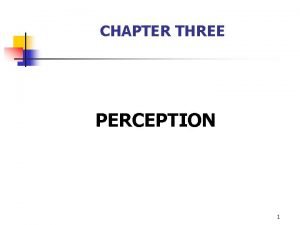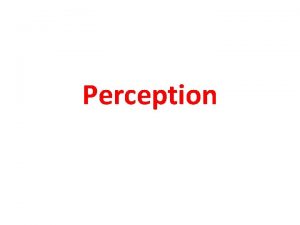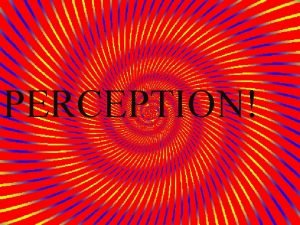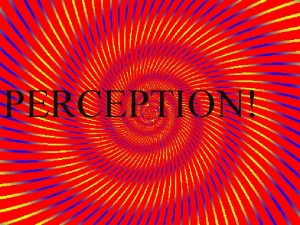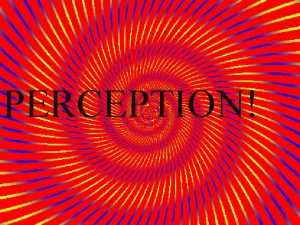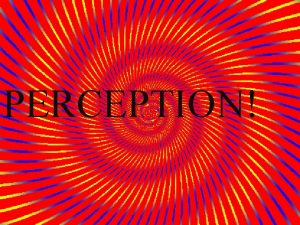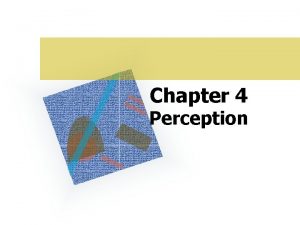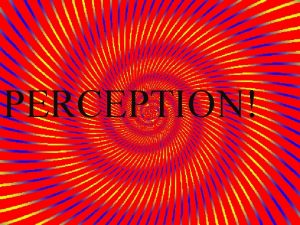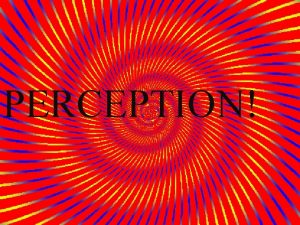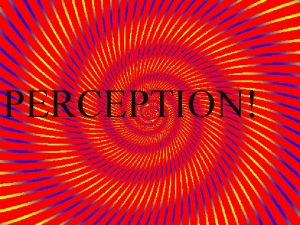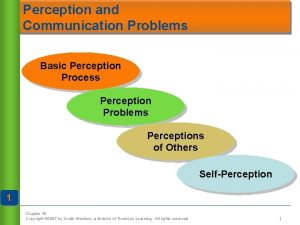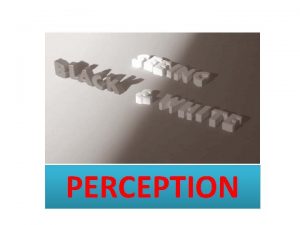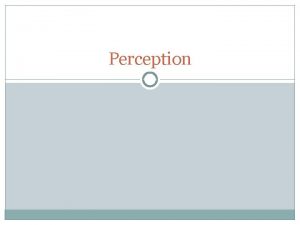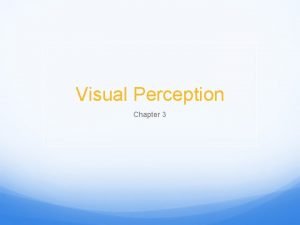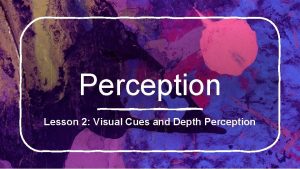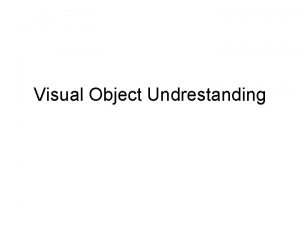VISUAL PERCEPTION DEFINITION Perception is the way in































- Slides: 31

VISUAL PERCEPTION

DEFINITION � Perception is the way in which the world appears to our mind. � Perception = Sensation + Meaning P=S+M

Looking at the whole picture: Gestalt principles. � Max Wertheimer, Wolfgang Kohler and Kurt Koffka were gestalt psychologists. They focused on how people interpret the world. � Gestalt psychologists developed a set of principles to explain perceptual organization. These principles are often referred to as the "laws of perceptual organization. " The Gestalt principles (laws) of perceptual organization concern the process whereby people categorize and organize stimulus information into meaningful units to make sense of the stimuli.

GESTALT PRINCIPLES OF PERCEPTUAL ORGANIZATION

FIGURE-GROUND Organization depends on what we see as figure (object) and what we perceive a ground (context).

Similarity principle (color) We tend to perceive objects that are similar to each other as forming a group

Similarity principle (shape)

Similarity principle (size)

Proximity principle We tend to perceive objects that are close to each other as forming a group

Continuity principle We tend to perceive smoothly flowing or continuous forms rather than disrupted of discontinuous ones

Closure principle we tend to complete objects that are not, in fact, complete (that actually have gaps in them).

Perceiving size and depth � An object can look the same size at different distances But retinal image size changes with distance › Increase distance : decrease retinal image size › Decrease distance : increase retinal image size � The fact that an object can look the same size regardless of changing retinal image size is referred to as size constancy

� These three disks look to be the same size, but at different depths. In fact, they vary greatly in terms of their retinal image sizes.

Depth perception � Depth perception involves interpretation of visual cues that indicate how near or far objects are. � To make judgments of distance, people relay on quite a variety of clue, which can be classified into two types: 1. Monocular cues 2. Binocular cues

Depth Perception: Monocular Depth Cues

� Depth cues that require the use of only one eye � Monocular depth cues include: › relative size › relative motion › interposition › relative height › texture gradient › relative clarity › linear perspective.

Monocular Depth Cues – Relative Size Using the perceived size of a familiar object to determine depth � The larger the object appears, the closer the object is to the viewer � The smaller the object appears, the farther away it is to the viewer. �

Monocular Depth Cues – Relative Motion (Motional Parallax) �When you ride in a moving vehicle and look out the side window, the objects you see outside appear to be moving in the opposite direction �Objects seem to be moving at different speeds – those closest to you appear to be moving faster than those in the distance �Objects very far away, such as the moon and the sun, appear to move in the same direction as the viewer

Relative Motion In this example, If the passenger fixes her gaze on the bridge, objects behind it will appear to move forward. The farther away the object is, the more slowly it will appear to move. Objects in front of the fixation point appear to move backward.

Monocular Depth Cues – Interposition � Method of determining depth by noting that closer objects partially obstruct/block the more distant objects � Also called “overlap”

Monocular Depth Cues – Relative Height � Method of determining depth by noting that distant objects appear higher in your field of vision than do closer objects. You know that the trees and houses are farther away than the lake because they are higher up in the drawing than the lake is.

Monocular Depth Cues – Texture Gradient � Method of determining depth by noting that distant objects have a blended or smoother texture than nearby objects Individual flowers are visible in the foreground, but in the distance they look like a smooth carpet.

Monocular Depth Cues – Relative Clarity (Aerial Perspective) � Method of determining depth by noting that distant objects are less clear than nearby objects The distant mountains look blue & hazy because of dust & moisture in the atmosphere.

Monocular Depth Cues– Linear Perspective � Method of determining depth by noting that parallel lines appear to converge in the distance The sides of the road seem to converge in the distance.

Monocular Depth Cues– Light and Shadow � Nearby objects reflect more light into our eyes. � Given two identical objects, the dimmer one seems farther away. Watch as the picture flips upside down.

Can you apply these principles to a painting? On Your White Board write the following: › › › › Relative Size Interposition Relative Height Texture Gradient Relative Clarity/Aerial Perspective Linear Perspective Light & Shadow

Explain how those terms are being used in this picture.

Depth Perception: Binocular Depth Cues

Binocular Cues � Depth cues that require the use of both eyes � The principal binocular cue is Retinal Disparity.

Retinal Disparity A binocular depth cue resulting from slightly different images produced by the separation of the retinas in the left and right eye � Because our eyes are about 2 ½ inches apart, the retina receives slightly different images of the world. � › The greater the difference between the two images, the closer the object is to the viewer. › The more alike the two images, the further away the object is perceived. Is most effective when the item is quite close to the person � Example: hold a pencil just in front of your nose and close one eye, then the other. The pencil should move showing the disparity. Now focus on something far away and do the same. It should not move very much showing less disparity. �

� Vision is not necessarily what we see but how our brain interprets the world around us, our own experiences can shape how we perceive this world. Seeing is believing.
 Gestalt visual perception
Gestalt visual perception Carolina visual perception kit
Carolina visual perception kit Visual perception in hci
Visual perception in hci Gestalt principle of visual perception
Gestalt principle of visual perception Key club meaning
Key club meaning Perbedaan one way dan two way anova
Perbedaan one way dan two way anova Threaded avl tree
Threaded avl tree Perbedaan one way anova dan two way anova
Perbedaan one way anova dan two way anova Hypothesis for two way anova
Hypothesis for two way anova One way anova vs two way anova
One way anova vs two way anova Two way anova adalah
Two way anova adalah The old way and the new way
The old way and the new way This way that way forwards backwards over the irish sea
This way that way forwards backwards over the irish sea Walk this way talk this way
Walk this way talk this way Labor land and capital
Labor land and capital Contoh bahasa pemrograman konvensional
Contoh bahasa pemrograman konvensional Hình ảnh bộ gõ cơ thể búng tay
Hình ảnh bộ gõ cơ thể búng tay Bổ thể
Bổ thể Tỉ lệ cơ thể trẻ em
Tỉ lệ cơ thể trẻ em Voi kéo gỗ như thế nào
Voi kéo gỗ như thế nào Tư thế worm breton
Tư thế worm breton Bài hát chúa yêu trần thế alleluia
Bài hát chúa yêu trần thế alleluia Các môn thể thao bắt đầu bằng tiếng bóng
Các môn thể thao bắt đầu bằng tiếng bóng Thế nào là hệ số cao nhất
Thế nào là hệ số cao nhất Các châu lục và đại dương trên thế giới
Các châu lục và đại dương trên thế giới Công thức tiính động năng
Công thức tiính động năng Trời xanh đây là của chúng ta thể thơ
Trời xanh đây là của chúng ta thể thơ Mật thư anh em như thể tay chân
Mật thư anh em như thể tay chân Làm thế nào để 102-1=99
Làm thế nào để 102-1=99 Phản ứng thế ankan
Phản ứng thế ankan Các châu lục và đại dương trên thế giới
Các châu lục và đại dương trên thế giới

